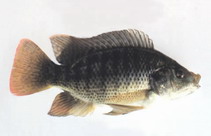| Diagnosis: |
Dorsal spines (total): 14-17; Dorsal soft rays (total): 11-15; Anal spines: 3-3; Anal soft rays: 8-11; Vertebrae: 28-31. Diagnosis: Adults: narrow preorbital bone (depth max. 21.5% of head length in fishes up to 21.3cm SL); lower pharyngeal jaw with short blade; no enlargement of the jaws in mature fish (lower jaw not exceeding and usually less than 36.8% head length) (Ref. 2). Caudal without regular dark vertical stripes (Ref. 2, 53405, 54467), but with a broad pink to bright red distal margin (Ref. 2). Breeding males assume an intense bright metallic blue on the head, a vermilion edge to the dorsal fin and a more intense pink on the caudal margin (Ref. 2, 54467). Breeding females with the edges of dorsal and caudal fins in a paler more orange color (Ref. 2). Juveniles: upper line of head profile running upward from snout at sharp angle; lower pharyngeal bone nearly triangular, teeth numerous but not densely crowded; dorsal and anal fin striped, with stripes running obliquely on the soft dorsal and longitudinally on the caudal fin; black Tilapia-mark on soft dorsal present; body dark; lower lip developed from beneath (Ref. 54566).
Description: deep bodied; teeth very small, typical for an algae feeder (Ref. 52307), in 3-5 rows in the jaws, bicuspid in the outermost (Ref. 2, 53405, 54467), tricuspid in the others (Ref. 2, 54467). Lower pharyngeal bone with bicuspid teeth, its toothed part as long as anterior part (Ref. 53405). Scales cycloid (Ref. 367, 2756, 54408), with fringes of the embedded part almost straight (Ref. 54408). Scales on cheek in 2-3 horizontal series; 5-7 scales between base of pectoral and pelvic fin (Ref. 2, 54467). 13.5-14.5 scales below upper lateral line before the pelvic fins (Ref. 367). 2 scales between upper and lower lateral line (Ref. 367, 2756). Upper lateral line with 20-23 scales, lower with 14-18 scales (Ref. 367, 2756). Microbranchiospines present on outer sides of arches 2 to 4 (Ref. 2). Dorsal fin edge thickened and notches between lappets closed in fully ripe males (Ref. 364, 54467). Last dorsal spine the longest (Ref. 367, 2756). Third anal spine a little shorter than last dorsal spine (Ref. 2, 2756, 54467), but stronger (Ref. 2, 54467). Pelvics not greatly produced; caudal often with rounded corners, usually scaly only at the base and between rays on upper and lower parts of the fin; genital papilla of mature male conical or with narrow bifid flange (Ref. 2, 54467).
Coloration: Juveniles: grey-brown to slightly golden (Ref. 52307), with vertical bars on sides (Ref. 53405). Specimens <10cm with well developed "Tilapia"-spot on soft dorsal fin (Ref. 2, 52307, 53405, 54467). Sometimes with vague vertical bars on caudal fin (Ref. 2, 3032). Adults: eye with red iris crossed by a black bar (Ref. 2). Ventral region pale silvery-grey (Ref. 2, 367, 3032, 52307). Lips often blackish (Ref. 367). Chin and chest may be blue-black (Ref. 2, 6465). Throat and belly sometimes yellowish but never reddish (Ref. 2756). Silvery and dark spots distributed all over the body (Ref. 52307). Sometimes with several vertical bars on body (Ref. 2, 3032, 31256, 52307), related to emotional state (Ref. 53405, 54467). Opercular spot generally present (Ref. 367, 2756, 54759), but may become totally invisible (Ref. 367). Pectoral fins greyish, pelvic fins blackish (Ref. 367, 2756). Dorsal fin (Ref. 2, 2756, 3032, 52307, 54467) and upper parts of caudal fin (Ref. 2, 367, 2756, 3023, 3032, 6465, 13851, 51850, 52307, 53405) with red margins. Soft dorsal and anal fin, and normally also the caudal fin, with numerous pale spots (Ref. 2, 2756, 3032, 31256, 52307, 54467, 54759). Spots on dorsal and anal fin in oblique rows (Ref. 367). Dorsal fin lappets dark, never red or pale (Ref. 51850). Adult males grey-blue, with head, from upper lips to eye, greenish-brown, becoming darker towards the back; courting males brilliant with metallic blue sparkles on the head (Ref. 52307), or intense metallic blue on the head, sometimes paler blue on the body, with a vermillion edge on the dorsal and a more intense pink caudal margin (Ref. 2, 6465, 54467). Breeding females with paler, more orange edges of dorsal and caudal fin (Ref. 2, 6465). Preserved specimens sometimes with black lateral band (Ref. 53405). |
| Biology: |
Cold tolerant (Ref. 23, 61, 55352), occuring at temperatures ranging from 8°-30°C (Ref. 2), tolerating up to 41 °C (Ref. 23). Tolerates fairly brackish conditions (Ref. 3, 23, 61, 2001, 6465, 54362). Forms schools; is sometimes territorial; inhabits warm ponds and impoundments as well as lakes and streams (Ref. 5723, 11028), in open water as well as among stones and vegetation (Ref. 11028). Feeds on phytoplankton and small quantities of zooplankton (Ref. 3, 61, 6465, 52307). Young fish have a more varied diet which includes large quantities of copepods and cladocerans (Ref. 2, 61, 6465), but they also take pieces of small invertebrates (Ref. 52307). Ovophilic, agamous (Ref. 52307), maternal mouthbrooder (Ref. 364, 52307). Sexual maturity in ponds reached at age of 5-6 months (Ref. 55352). Reproduces in both fresh and brackish water (Ref. 61, 5723). Good taste (Ref. 61). |

